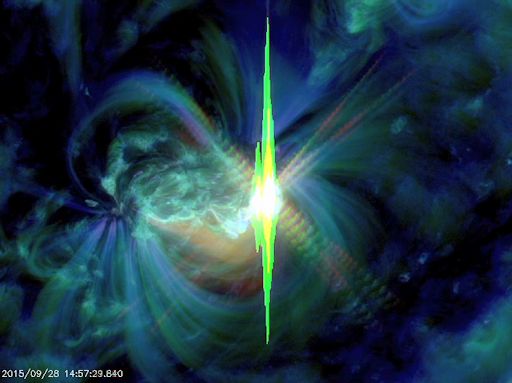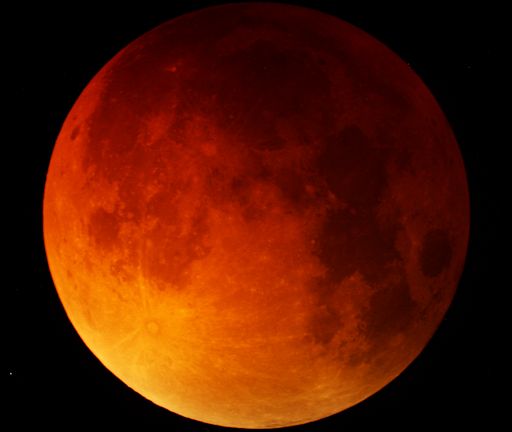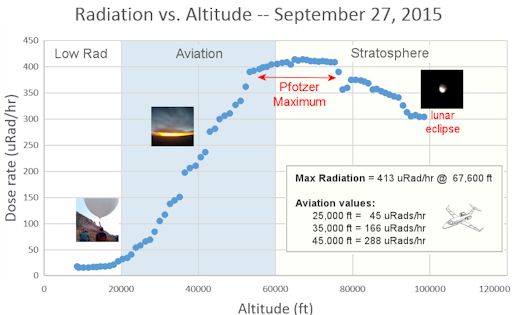Marianne's Heaven On Earth Aurora Chaser Tours Chasethelighttours.co.uk invites you to join them in their quest to find and photograph the Aurora Borealis. Experience the winter wonderland in the Tromsø Area. | | |
MANY FLARES, FEW CMEs: Sunspot AR2422 is crackling with solar flares. The behemoth active region has produced more than 6 M-flares in the past 24 hours, inluding this intense M7.6 category explosion recorded by NASA's Solar Dynamics Observatory on Sept. 28th:

Extreme UV radiation from the flare ionized the top of Earth's atmosphere and caused a brief low-frequency radio blackout over South America and the Atlantic ocean: blackout map. Similar blackouts are occuring every few hours today as the flare activity continues. The frequencies most affected are below 10 MHz.
Despite this high solar activity, there have been no major CMEs. All of the flares have been brief and impulsive. Generally, CMEs require longer-lasting explosions.
AR2422 has an unstable 'beta-gamma-delta' magnetic field that could erupt again at any moment. NOAA forecasters estimate a 70% chance of additional M-class solar flares and a 25% chance of X-flares during the next 24 hours. Solar flare alerts: text or voice
WHAT MADE THE LUNAR ECLIPSE SO DARK? On Sunday night, Sept. 27th, the supermoon passed through the shadow of Earth, producing a total lunar eclipse visible from the Americas, Europe, Africa and parts of Asia. "It was one of the darkest lunar eclipses I have ever seen," reports Kevin R. Witman, who sends this picture from Cochranville, Pennsylvania:

Other observers (see the gallery) also remarked on the darker hue of this lunar eclipse, compared to others in recent years. What caused the change? Atmospheric scientist Richard Keen of the University of Colorado offers one reason: "Supermoon eclipses should be a bit darker. Because of its closeness to Earth, a supermoon passes deeper into the shadow of our planet."
Working independently, Steve Albers of NOAA and Helio Vital of REA/Brazil have suggested another reason: aerosols in the atmosphere.
"Earth's stratosphere is no longer completely clean of volcanic ashes," says Vital. "In fact, lingering aerosols from the explosion of Calbuco, five months ago, may be to blame for that excessive darkening."
Calbuco is a volcano in Chile. After it erupted in April 2015, colorful sunsets were observed around the southern hemisphere for months. Recently, Albers has noted an increase in purple and yellow sunsets around his home town, Boulder CO, and elsewhere. These are telltale colors of volcanic exhaust.
"A thin veneer of aerosols from Calbuco may have now spread to the northern hemisphere," Albers says. "In addition, we could be seeing the effects of residual smoke from forest fires at high altitudes, or the general increase in sulfate pollution that has been documented on a global basis."
Richard Keen, who is a leading expert on volcanic aerosols and lunar eclipses, says "the Sept. 27th eclipse was about 0.5 magnitudes darker than expected for a clear stratosphere. A slight layer of aerosols in the upper troposphere/lower stratosphere might explain this. Also, the Moon passed through the southern part of Earth's shadow, so southern hemisphere aerosols (such as those produced by Calbuco) would have greater effect."
Keen says that he is still "crunching the numbers," and we may have more information soon...
Realtime Eclipse Photo Gallery
COSMIC RAYS DURING THE LUNAR ECLIPSE: On the evening of Sept. 27th, Spaceweather.com and the students of Earth to Sky Calculus conducted a routine flight of their cosmic ray payload to the stratosphere. Routine, that is, except for one thing: the balloon flew at night during a lunar eclipse. One of the goals of the flight was to compare radiation levels at night to those recorded during the day. Here are the data they recorded:

Compare the Sept. 27th plot of radiation vs. altitude to a similar plot recorded in broad daylight only a few days earlier. In the stratosphere, radiation levels were the same to within 1%. At aviation altitudes, radiation levels were the same to within about 3%. There was no significant difference, night vs. day.
This simple experiment highlights something that is already well known to researchers. Cosmic rays in the atmosphere come mainly from deep space. They are accelerated toward Earth by supernovas, colliding neutron stars, and other violent events in the Milky Way. Flying at night is no safeguard against these energetic particles because they are everpresent, coming at us from all directions, day and night.
The payload also contained a unique biological radiation sensor consisting of multiple strains of yeast. Data from the microbes are still being reduced. Expect updates in a few days after the colonies have time to grow.
Realtime Space Weather Photo Gallery
Realtime Aurora Photo Gallery
Realtime Sprite Photo Gallery
| | Cosmic Rays in the Atmosphere |
| Situation Report -- Sept. 29, 2015 | Stratospheric Radiation (+37o N) |
| Cosmic ray levels are elevated (+5.9% above the Space Age median). The trend is flat. Cosmic ray levels have increased +0% in the past month. |
| Sept. 06: 414 uRad/hr |
| Sept. 12: 409 uRad/hr |
| Sept. 23: 412 uRad/hr |
| Sept. 25: 416 uRad/hr |
| Sept. 27: 413 uRad/hr |
These measurements are based on space weather balloon flights, described below. Introduction: Once a week, and sometimes more often, Spaceweather.com and the students of Earth to Sky Calculus fly "space weather balloons" to the stratosphere. These balloons are equipped with radiation sensors that detect cosmic rays, a form of space weather important to people on Earth. Cosmic rays can alter the chemistry of the upper atmosphere, seed clouds, spark exotic forms of lightning, and penetrate commercial airplanes. This last point is of special interest to the traveling public. Our measurements show that someone flying back and forth across the continental USA, just once, can absorb as much ionizing radiation as 2 to 5 dental X-rays. From now on we will present the results of our regular weekly balloon flights in this section of our web site. Here is the radiation profile from our latest flight:

Radiation levels peak at the entrance to the stratosphere in a broad region called the "Pfotzer Maximum." This peak is named after physicist George Pfotzer who discovered it using balloons and Geiger tubes in the 1930s. Radiation levels there are nearly 100x sea level.
Note that the bottom of the Pfotzer Maximim is near 55,000 ft. This means that some high-flying aircraft are not far from the zone of maximum radiation. Indeed, according to the Sept. 27th measurements, a plane flying at 45,000 feet is exposed to 288 uRads/hr. At that rate, a passenger would absorb about one dental X-ray's worth of radiation in 5 hours.
The radiation sensors onboard our helium balloons detect X-rays and gamma-rays in the energy range 10 keV to 20 MeV. These energies span the range of medical X-ray machines and airport security scanners.
Stay tuned for improvements to this section in the days and weeks ahead as we develop a glossary and better plain language strategies for communicating this information. Suggestions are welcomed.
Every night, a network of
NASA all-sky cameras scans the skies above the United States for meteoritic fireballs. Automated software maintained by NASA's Meteoroid Environment Office calculates their orbits, velocity, penetration depth in Earth's atmosphere and many other characteristics. Daily results are presented here on Spaceweather.com.
On Sep. 29, 2015, the network reported 10 fireballs.
(10 sporadics)

In this diagram of the inner solar system, all of the fireball orbits intersect at a single point--Earth. The orbits are color-coded by velocity, from slow (red) to fast (blue). [Larger image] [movies]
Potentially Hazardous Asteroids (
PHAs) are space rocks larger than approximately 100m that can come closer to Earth than 0.05 AU. None of the known PHAs is on a collision course with our planet, although astronomers are finding
new ones all the time.
On September 29, 2015 there were 1612 potentially hazardous asteroids.
Notes: LD means "Lunar Distance." 1 LD = 384,401 km, the distance between Earth and the Moon. 1 LD also equals 0.00256 AU. MAG is the visual magnitude of the asteroid on the date of closest approach. | | The official U.S. government space weather bureau |
| | The first place to look for information about sundogs, pillars, rainbows and related phenomena. |
| | Researchers call it a "Hubble for the sun." SDO is the most advanced solar observatory ever. |
| | 3D views of the sun from NASA's Solar and Terrestrial Relations Observatory |
| | Realtime and archival images of the Sun from SOHO. |
| | from the NOAA Space Environment Center |
| | the underlying science of space weather |
| | Web-based high school science course with free enrollment |

